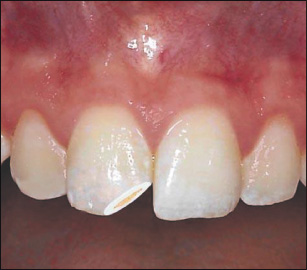Crown Fracture without Pulp Exposure
OBJECTIVES
1 Based on clinical findings, differentiate between the types of uncomplicated crown fractures: infractions, enamel, enamel–dentin without pulp exposure.
2 Make treatment decisions based on such factors as the extent of injury, development of the tooth and status of the pulp.
3 Provide appropriate treatment for the various types of crown fractures.
4 Recognize crown fracture situations that permit fragment reattachment.
DESCRIPTION AND CLINICAL APPEARANCE

Infraction is a disruption of enamel prisms without loss of tooth substance extending from the enamel surface to the dentino–enamel junction (right lateral incisor). Enamel fracture is the loss of tooth substance confined to enamel (right central incisor). Enamel–dentin fracture (uncomplicated crown fracture) is the loss of tooth substance confined to enamel and dentin, but not involving the pulp (left central incisor).
Fractures may appear as craze lines within the enamel (infractions) or as loss of tooth substance involving only enamel or enamel and dentin. Infraction lines are usually best seen when the light beam is directed parallel to the long axis of the tooth. Besides describing only the most obvious injury (i.e. crown fracture), it is very important to diagnose concomitant luxation injuries, as these have a very significant influence on pulpal outcome.
RADIOGRAPHIC APPEARANCE
Stay updated, free dental videos. Join our Telegram channel

VIDEdental - Online dental courses


